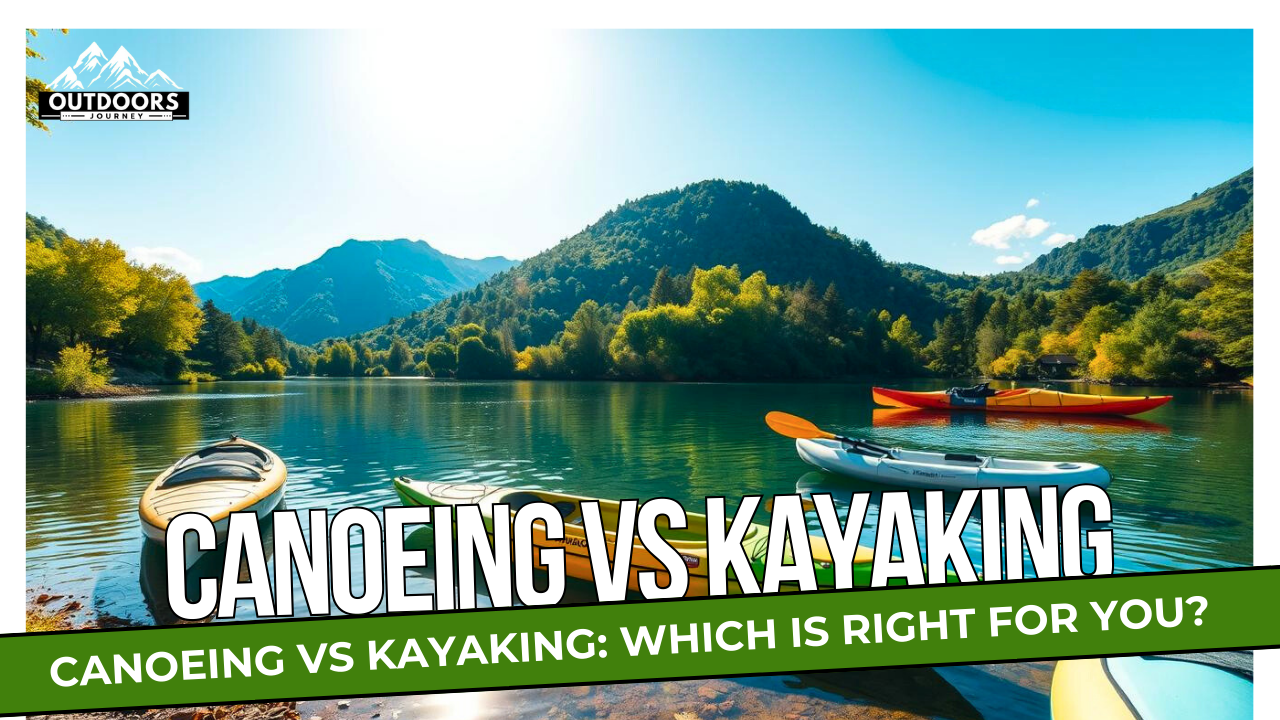Did you know kayaks are more common in the U.S. than canoes? As paddle sports grow, many wonder which is best for them. Choosing between canoeing and kayaking involves more than just liking one over the other. It’s about stability, how easy they are to move, and the overall water experience.
This guide will help you understand what makes each craft special. We’ll look at their history and how they’re used today in outdoor activities.
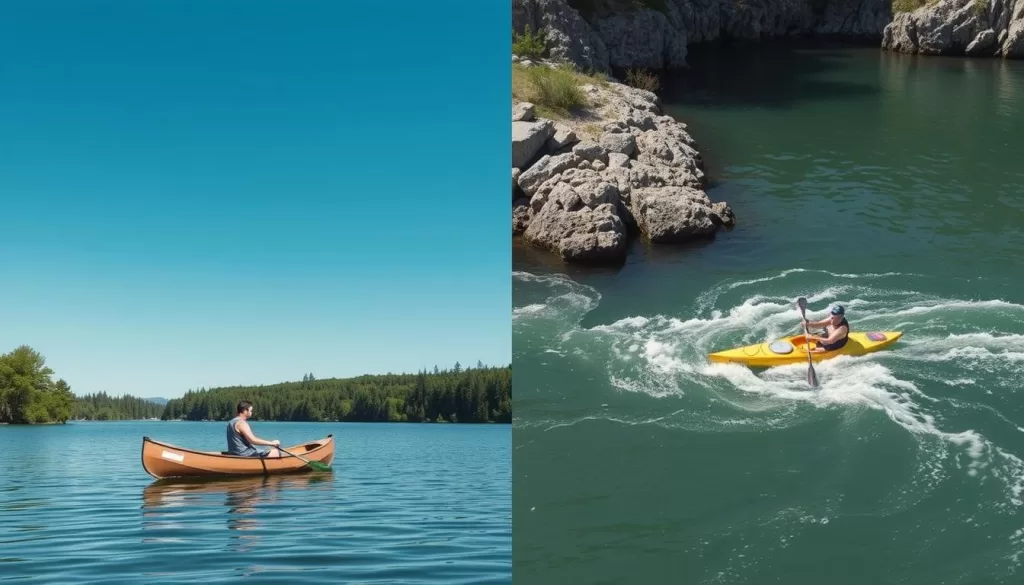
Whether you’re into the excitement of kayaking or the traditional canoe trip, knowing the differences can help. You’ll learn what each offers for your water adventures. Let’s dive into the world of paddle sports and see what each has to offer!
Key Takeaways
- Kayaks are generally faster and offer more maneuverability.
- Canoes provide greater stability and ease of access for all users.
- Both paddle sports have unique benefits depending on personal preferences.
- Understanding the design differences can impact your paddling experience.
- Choosing the right craft depends on your planned activities and abilities.
- 1 Introduction to Paddle Sports
- 2 The Main Differences Between Canoes and Kayaks
- 3 Types of Canoes and Their Uses
- 4 Types of Kayaks and Their Uses
- 5 Paddling Techniques for Canoeing vs Kayaking
- 6 Canoeing vs Kayaking: Stability and Control
- 7 Gear and Equipment Needed for Paddling
- 8 Safety Considerations for Canoeing and Kayaking
- 9 Health Benefits of Canoeing and Kayaking
- 10 Canoeing vs Kayaking for Beginners
- 11 Best Environments for Canoeing and Kayaking
- 12 Canoeing and Kayaking in Nature
- 13 Family and Group Activities: Canoeing vs Kayaking
- 14 The Environmental Impact of Canoeing and Kayaking
- 15 Choosing the Right Type of Trip
- 16 Personal Preferences and Experiences
- 17 Canoeing vs Kayaking: Cost Considerations
- 18 Conclusion
- 19 FAQ
- 20 Source Links
Introduction to Paddle Sports
Paddle sports are a great way to enjoy the outdoors and stay active. You can choose from exciting adventures or calm moments on the water. Activities like canoeing and kayaking let you connect with nature and relax.
Recreational paddling is loved for its flexibility. Families can have fun on a quiet lake, while thrill-seekers can tackle rough rivers or waves. Paddle sports welcome everyone, no matter their skill level.
Paddle sports offer something for everyone. You can paddle with friends or go solo for a moment of reflection. Exploring new places on the water is part of the fun. Dive into paddling and discover amazing experiences.
The Main Differences Between Canoes and Kayaks
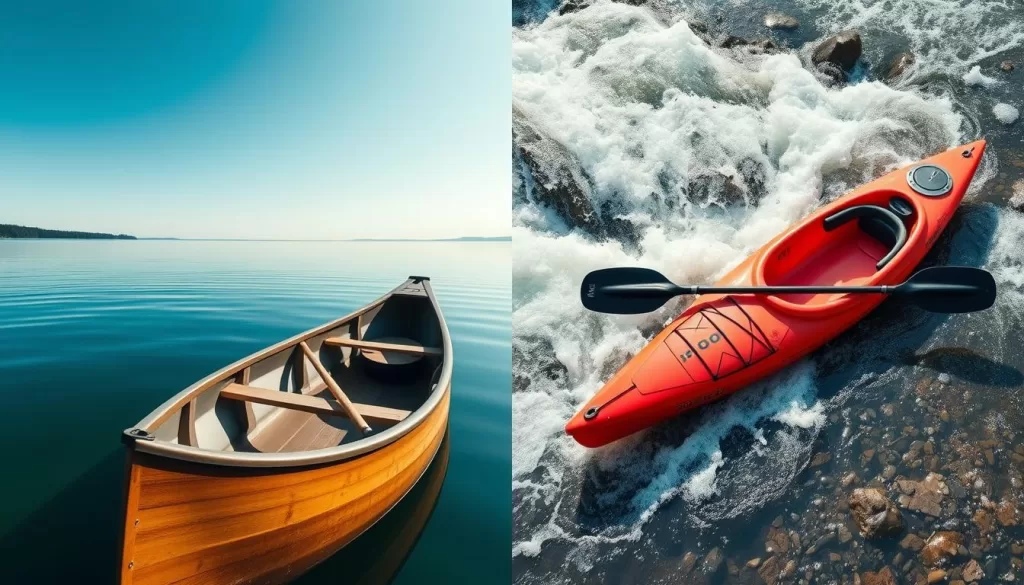
Knowing the differences between canoes and kayaks helps you make better choices in paddle sports. Each has its own unique feel, with clear differences in design, structure, and how you use them.
Vessel Design and Structure
The canoe design has an open deck, making it easy to get in and out. It’s great for long trips because you can carry more stuff. On the other hand, the kayak structure has a closed deck. This keeps you dry in bad weather but means you can’t carry as much.
Canoes are wider and more stable, so they’re less likely to tip over. This is good for calm waters. Kayaks, being narrower and lighter, are faster and better for racing.
Solo vs Tandem Options
Solo canoes are perfect for peaceful trips or fishing alone. You don’t need a partner. Tandem kayaks, however, are great for groups or families. They’re perfect for sharing the water with others.
Both can fit more than one person, but canoes are better for groups because they’re bigger. Your choice depends on whether you want to go fast, stay stable, or paddle with someone. Knowing the basics of canoe vs kayak helps pick the right one for your adventures.
Types of Canoes and Their Uses
Canoes come in many types, each made for different activities and places. Knowing about the different canoes helps you pick the best one for your water adventures.
Recreational Canoes
Recreational canoes are great for calm waters. They’re perfect for families and beginners. These canoes are stable, making them easy to paddle on lakes and slow rivers.
They have wide sides for comfortable seating and easy paddling. This makes your outdoor time more enjoyable.
Whitewater Canoes
Whitewater canoes are for those who love excitement in rough waters. They’re built for quick moves and agility. This makes them perfect for fast streams and rapids.
They’re shorter than other canoes, which helps with fast turns. Paddling a whitewater canoe is challenging but very exciting.
Tandem Canoes
Tandem canoes are for two or more paddlers. They’re great for family trips or group outings. These canoes are stable and spacious, making them perfect for paddling together.
They bring people together, making your canoe trip more fun. You and your friends can explore different waterways together.
Types of Kayaks and Their Uses
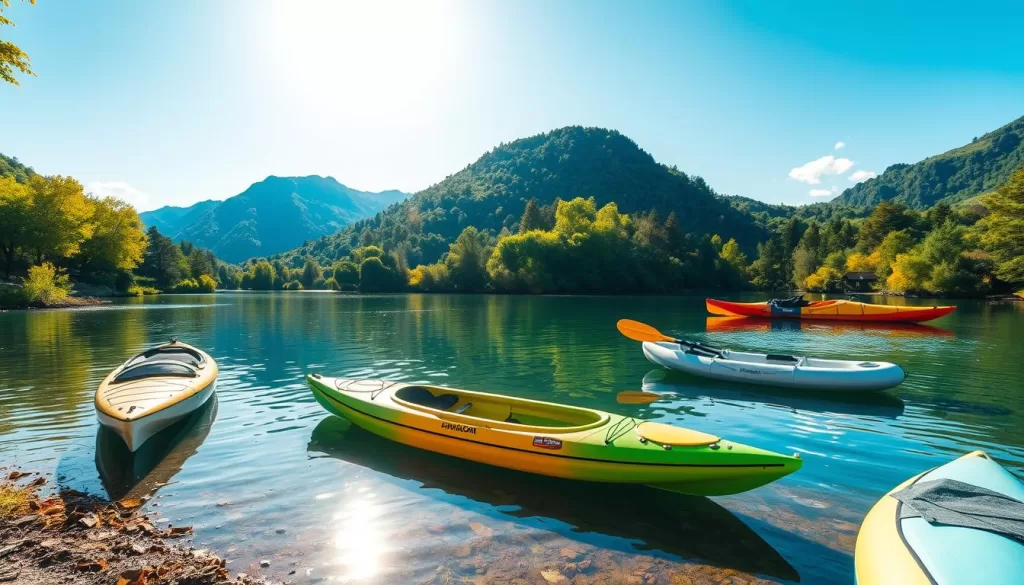
Exploring waterways is more fun when you know about the different kayaks. Each type is made for a specific use and environment. Let’s look at recreational, whitewater, and inflatable kayaks.
Recreational Kayaks
Recreational kayaks are great for beginners and those who enjoy calm waters. They are shorter than 14 feet and have wide bodies. This makes them stable and easy to get in and out of.
They are perfect for relaxing paddles and activities like bird watching or photography.
Whitewater Kayaks
Whitewater kayaks are built for rough waters. They are stable and easy to maneuver. Made from durable materials, they can handle tough conditions.
Their design allows for quick turns and fast runs. They are ideal for those who love adventure.
Inflatable Kayaks
Inflatable kayaks are super convenient for casual paddlers. They are light, easy to carry, and take up little space. Made from strong materials, they are good for both fun and fishing.
They may not be as solid as hard-shell kayaks, but they are affordable and still lots of fun.
| Type of Kayak | Length | Stability | Best Use | Price Range |
|---|---|---|---|---|
| Recreational Kayaks | Under 14 feet | High | Leisure paddling, birding | $200 – $900 |
| Whitewater Kayaks | Varied, compact | Medium to High | Rivers, rapids | $700 – $1,500 |
| Inflatable Kayaks | Varied, portable | Medium | Casual paddling, fishing | $100 – $800 |
Paddling Techniques for Canoeing vs Kayaking
Learning the paddling techniques for canoes and kayaks can really improve your time on the water. Canoeing uses canoe strokes with a single-bladed paddle. You paddle from one side to the other, which works your core and improves coordination.
Kayaking, on the other hand, uses kayak paddles with two blades. This design lets you paddle in a rhythmic way, moving your arms left and right. It’s important to keep a steady rhythm and balance to master different paddling styles.
| Paddling Techniques | Canoeing | Kaying |
|---|---|---|
| Paddle Type | Single-bladed | Double-bladed |
| Stroke Style | Alternating sides | Left and right rhythm |
| Core Engagement | High | Moderate |
| Control in Wind | Less effective | More effective |
| Wave Performance | Less stable | More stable |
| Steering | Requires more technique | Generally easier to maneuver |
Both canoeing and kayaking have their own special qualities. They appeal to different paddling styles. By learning these paddling techniques, you’ll not only get better but also have more fun in these exciting water sports.
Canoeing vs Kayaking: Stability and Control
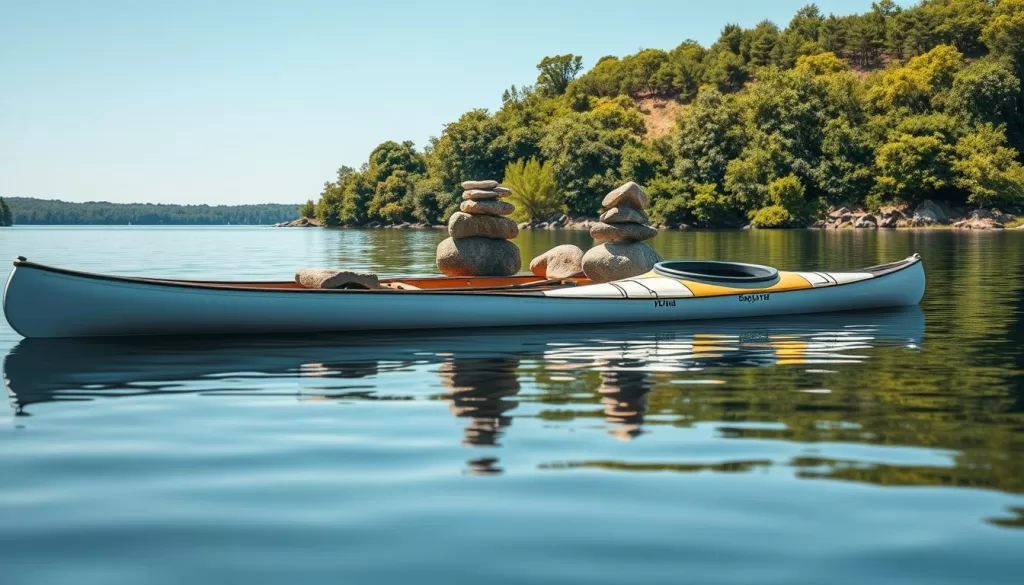
Choosing between canoeing and kayaking means understanding stability and control. Each boat has its own way of handling on the water. Design, buoyancy, and paddling techniques are key for both canoe and kayak.
Understanding Canoe Stability
Canoes are more stable than kayaks, great for calm waters. Their wide shape gives them good initial stability, perfect for family trips. But, they can struggle in choppy waters.
Canoes need teamwork to steer well, as they might zig-zag. Their high sides and ends also make them harder to control in the wind.
Understanding Kayak Stability
Kayaks offer a different feel with their sleek design. They’re better in rough waters. Kayaks may feel unstable at first, but they’re easier to control once moving.
Kayakers use double-bladed paddles for efficient strokes. This helps with better control and maneuverability.
Both canoes and kayaks help build strength and improve fitness. Learning to paddle each can be challenging. But, mastering kayak control is often quicker for beginners. Your choice depends on what you prefer, your planned activities, and safety.
| Aspect | Canoeing | Kayaking |
|---|---|---|
| Stability | Higher initial stability; ideal for calm water | Higher secondary stability; better in rough water |
| Paddle Type | Single-bladed paddles, requires alternating strokes | Double-bladed paddles, allows for continuous strokes |
| Maneuverability | Less maneuverable, needs more paddler coordination | More maneuverable; easier to steer accurately |
| Ideal Conditions | Best for calm, peaceful days | Adaptable to various conditions, including windy days |
Knowing these differences helps you make better choices in paddle sports.
Gear and Equipment Needed for Paddling
Going on a canoeing or kayaking trip means picking the right gear. The right equipment keeps you safe and comfy. Here’s what you need to know about the best paddling gear.
Essential Gear for Canoeing
Canoeing needs special gear for easy use and function. Here’s what you should get:
- Canoe: Choose a sturdy canoe for your waterway.
- Paddle: Single-bladed paddles work best for straight paths.
- Life jacket: A personal flotation device is key for safety.
- Dry bags: Keep your stuff safe and dry.
- Bailer: A Clorox bottle bailer removes water well.
- Safety equipment: Include throw lines and flotation devices for emergencies.
Essential Gear for Kayaking
Kayaking needs special gear for the best experience. Here’s what you need:
- Kayak: Pick from sit-on-top or traditional models.
- Paddle: Use a double-bladed paddle for better propulsion.
- Spray skirt: Keeps you dry in rough water.
- Life jacket: Always wear a reliable personal flotation device.
- Manual bilge pump: Useful for emptying water from your kayak.
- Fishing rod holders: Essential for anglers to secure their gear.
Quality paddling gear prepares you for surprises. Don’t forget safety items like whistles and waterproof phone cases. They ensure a worry-free time on the water.
| Item | Canoeing Equipment | Kayaking Essentials |
|---|---|---|
| Canoe/Kayak | Standard canoe designed for open waters | Varieties include sit-on-top and traditional kayaks |
| Paddle Type | Single-bladed | Double-bladed |
| Water Removal | Bailer (homemade) | Manual bilge pump |
| Safety Gear | Life jacket, throw lines, flotation devices | Life jacket, spray skirt |
Safety Considerations for Canoeing and Kayaking
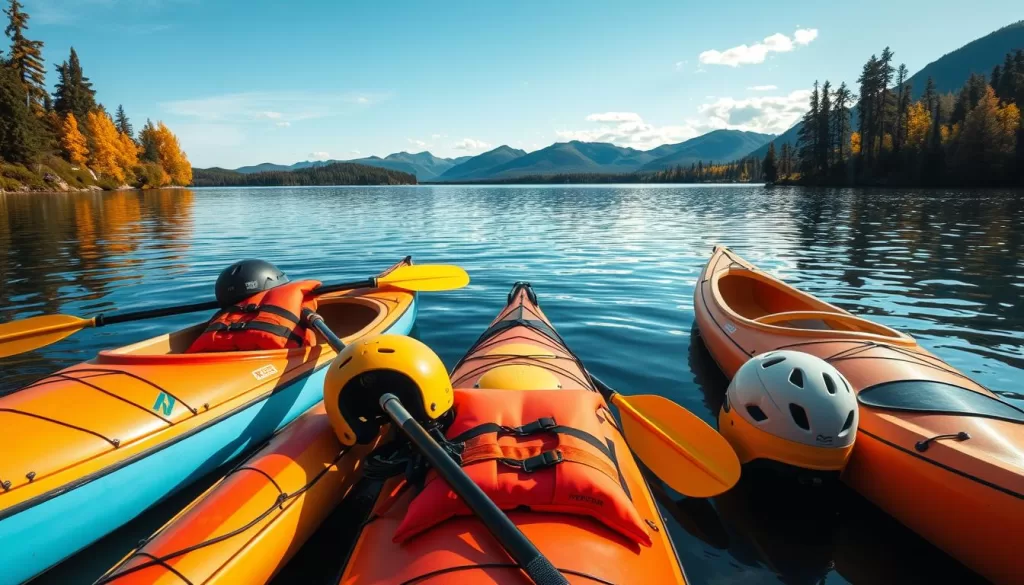
Canoeing and kayaking are fun and adventurous. But, safety is key. In 2018, the U.S. Coast Guard reported 4,145 boating accidents, with 630 deaths. Many of these were due to not being prepared or following safety rules.
Wearing life jackets is crucial to avoid fatal accidents. Make sure they fit right and are on at all times. Also, wear clothes that match the weather and water to stay safe and comfortable.
Before you go, check the weather and water conditions. Know your surroundings for obstacles like rocks or branches. For beginners, stick to areas that fit your skill level to avoid accidents.
- Inform someone about your plans, including your destination and expected return time.
- Paddle with a partner to enhance safety.
- Inspect your canoe or kayak regularly for any damage, such as leaks or cracks.
- Carry necessary safety equipment, including a first aid kit and communication devices.
- Stay hydrated and avoid paddling under the influence of alcohol or drugs.
If you capsize, keep your feet downstream to avoid getting caught in debris. Taking a safety course can improve your skills and safety. Always be aware of the weather and carry a weather radio for alerts.
By following these safety tips, you can enjoy paddling safely. It makes for a memorable experience on the water.
Health Benefits of Canoeing and Kayaking
Canoeing and kayaking offer many health benefits that improve your overall well-being. These water sports are great for both physical and mental health. Plus, you get to enjoy the outdoors.
Physical Fitness and Strength Building
Canoeing and kayaking are great for building strength. They work your arms, shoulders, chest, and back with each stroke. Your core gets stronger too, thanks to the rotational movements.
Your legs also get a workout, helping to strengthen them. This is because you need to press down to keep the canoe or kayak stable. These activities also boost your heart rate, making your heart stronger.
They are especially good for older people, helping to keep their hearts healthy. Paddling can also help you lose weight, as it burns calories. Plus, it’s low-impact, which means it’s easier on your body than high-impact activities like running.
Mental Health Benefits of Water Sports
Water activities are great for your mental health. They offer a break from daily stress. Paddling releases endorphins, which make you feel good and can help with pain.
These activities also promote mindfulness, as you focus on the natural surroundings. Being outdoors can help you relax and appreciate nature. Plus, paddling with others can help you make friends and improve your social skills.
| Health Benefits | Physical Impact | Mental Impact |
|---|---|---|
| Upper-Body Strength | Increased chest, arm, shoulder, and back strength | Enhanced self-esteem from physical activity |
| Core Strength | Improved torso muscle engagement | Focus on stability promotes mindfulness |
| Leg Strength | Improved lower body strength | Balanced body awareness |
| Cardiovascular Fitness | Strengthened heart | Improved overall mental clarity |
| Weight Loss | Caloric burn during activity | Boosted mood from physical achievement |
| Social Interaction | Enhanced teamwork and cooperation | Increased happiness and connection |
| Mindfulness | N/A | Promotion of relaxation and lower stress |
Canoeing vs Kayaking for Beginners
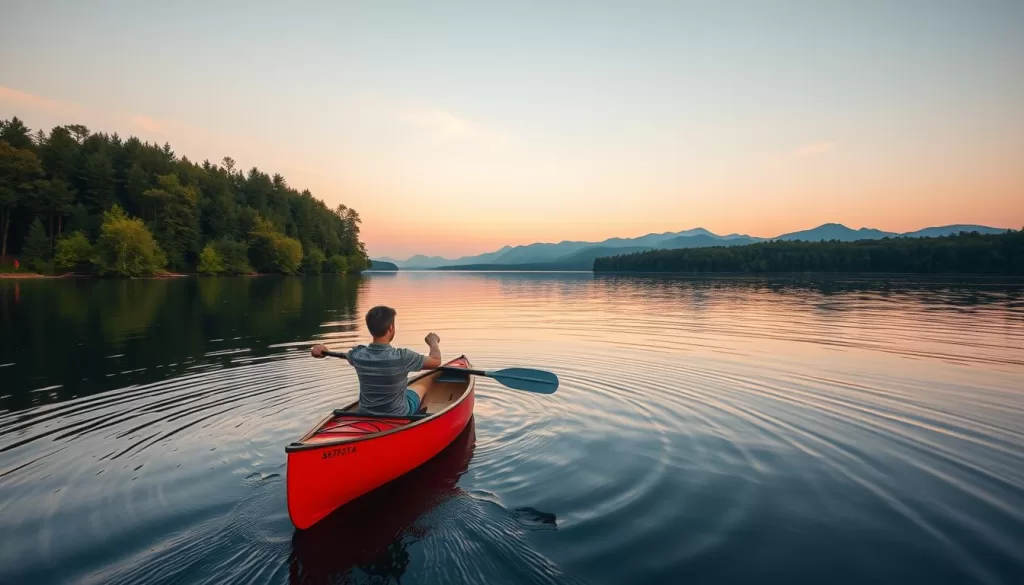
Starting your paddle sports journey is thrilling for new kayakers and paddling beginners. Each boat type brings its own adventure. Canoes are stable and open, while kayaks are for those who love quick turns and exciting rides.
Learning Curve for New Paddlers
For beginners, canoeing is often easier. You can sit comfortably and enjoy calm waters. Canoes are great for long trips, especially with families.
Kayaks, being lower in the water, need more skill. They’re best for fast rivers where quick moves are key. Kayakers learn important skills like self-rescue, which can be easier than in canoes.
Finding Beginner-Friendly Locations
Finding the right place to start is key. Look for quiet lakes, calm rivers, and places with beginner lessons. State parks often have guided tours for new paddlers.
These areas are big enough to practice without stress. Some even let you carry camping gear, making your trip better.
Exploring different spots is exciting. Both canoes and kayaks lead to beautiful nature adventures. Your choice is just the beginning of many fun trips.
Best Environments for Canoeing and Kayaking
The environment greatly influences your paddling experience. Knowing the difference between calm and rough water is key. Each environment has its own challenges and benefits. Choosing the right place for your adventure is crucial.
Calm Waters vs Rough Conditions
Calm water places like lakes and slow rivers are great for beginners. They offer a peaceful setting for learning and enjoying nature. Canoeing here lets you see the scenery and learn skills without fear.
Rough water paddling, however, is for the more experienced. Whitewater rivers and coastal areas offer excitement and a chance for thrilling moves. Knowing the difference helps you pick the right spot for your skill level.
Ideal Bodies of Water for Each Craft
Canoes are best for exploring calm waters. Lakes, lazy rivers, and calm estuaries are perfect for them. These places are stable and comfortable, ideal for family outings or relaxing.
Kayaks, on the other hand, are made for swift waters. They handle waves and currents well. River rapids, coastal surf, and rough water areas are great for kayaking. Knowing what each boat is good for helps you choose the best spot.
Canoeing and Kayaking in Nature
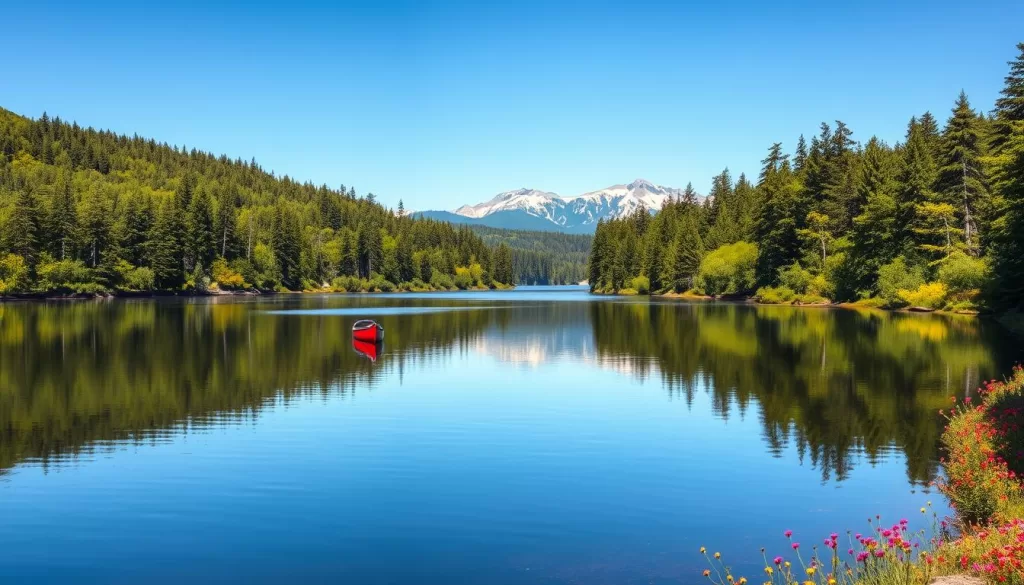
Paddling in nature offers a chance to explore stunning landscapes. It lets you connect with nature quietly and serenely. Whether you’re on a calm lake or a winding river, it deepens your love for the environment.
Connecting with the Outdoors
Canoeing and kayaking bring you closer to nature. The quiet of paddling lets you feel a deep connection with the environment. As you paddle, you notice small changes like leaves rustling or water rippling.
These activities let you slow down and see the beauty of lakes, rivers, and their creatures.
Wildlife Observations While Paddling
One of the best parts of paddling is seeing wildlife. Kayaking and canoeing let you reach places big boats can’t. This gives you a special view of animals in their homes.
Being quiet is important to get close to animals. You might see birds, turtles, or otters without scaring them away. Plan your trip to places with lots of wildlife. Don’t forget binoculars to see more and keep wildlife safe.
| Activity | Wildlife Observation Tips |
|---|---|
| Canoeing | Use a canoe paddle to reduce noise when approaching wildlife. |
| Kayaking | Move slowly and alternate between paddling and observing. |
| Both | Utilize waterproof equipment like dry bags to keep your electronics safe while you explore. |
Family and Group Activities: Canoeing vs Kayaking
Outdoor adventures are great for bonding and making memories. When planning activities, choosing between canoes and kayaks is key. Each has its own benefits, so it’s important to think about what you need before heading out.
Choosing the Right Craft for Family Trips
Canoes are perfect for big family trips because they’re roomy. They can hold lots of gear, food, and even kids. Canoes also make it easy for groups to paddle together, building friendships.
Kayaks are great for families who love adventure. Tandem kayaks let you paddle together, making it fun and exciting. Kayaks are also easier to move around because they’re smaller than canoes.
The right choice depends on who’s going. Kids can ride in tandem kayaks, while older ones can paddle their own. Kayaking is safe, letting families enjoy nature together.
Here’s a quick comparison to help you decide:
| Feature | Canoes | Kayaks |
|---|---|---|
| Ideal for Group Size | Suitable for larger groups | Best for pairs or small groups |
| Weight Capacity | Up to 900 pounds | 300-350 pounds (recreational), 500-600 pounds (tandem) |
| Ease of Transport | Bulky and challenging to transport | More convenient and often inflatable |
| Stability | High stability due to wider design | Requires basic skills but offers agility |
| Best For | Shared experiences and longer trips | Fast-paced adventures |
Knowing what’s best for your family makes outings fun and memorable. Whether you pick canoes for a calm trip or kayaks for excitement, both are great for bonding and making memories.
The Environmental Impact of Canoeing and Kayaking
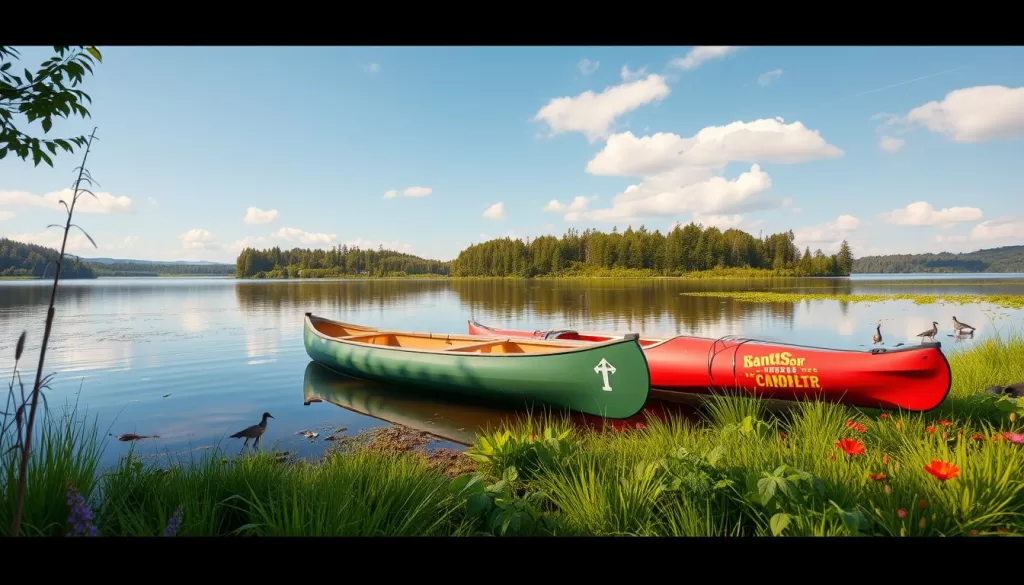
Canoeing and kayaking are great ways to enjoy nature. But, they also come with big responsibilities for sustainability in paddling. These activities are mostly light on the environment. However, they can still harm nature if we’re not careful.
Choosing to paddle with our own power helps reduce carbon emissions. This choice helps protect our natural world. But, the use of electric motors in kayaks raises concerns about battery waste and how it affects our environment.
Kayaking can also help us connect with wildlife. By caring for local ecosystems and joining conservation efforts, we help keep the environment healthy. But, we must avoid disturbing wildlife, especially when they’re nesting.
Launching boats without care or doing harm to shorelines can damage habitats. Also, pollution from trash and chemicals harms our water. It’s up to each of us to keep our waterways clean, showing the importance of eco-friendly paddling.
Preventing the spread of invasive species is another big issue. Keeping our gear clean is key to protecting water bodies. By following best practices, we can keep the environmental impact of canoeing and kayaking low, supporting sustainability in paddling.
Choosing the Right Type of Trip
Planning your next water adventure is key. You might choose short day trips or multi-day canoe trips. Each has its own benefits and challenges. Knowing your schedule, goals, and what you need will help you pick the best option.
Short Day Trips vs Multi-Day Expeditions
Short day trips are great for a quick break. They let you explore local waters, like calm lakes or fast rivers. You only need basic gear and can plan quickly. A few hours can be a great kayaking experience.
Multi-day canoe trips need more thought. They let you explore wilderness and camp under the stars. You can carry more gear, which is key for overnight stays. Canoes have lots of room for your stuff.
Both trips have their own hurdles. Canoes are stable and hold a lot, but hard to move. Kayaks are lighter and faster, but can’t carry as much. This affects your choice for day trips or longer trips.
Your decision depends on what you want to do, how much time you have, and what you like. Thinking about these things makes planning your trip more fun and rewarding.
Personal Preferences and Experiences

Choosing between a canoe and a kayak depends on what you like and what you’re used to. Each has its own benefits for different paddling goals. Think about what makes you happy on the water. Do you want a calm day or an exciting adventure?
Comfort in a Canoe vs Kayak
Canoes are known for their roomy seats, perfect for families or fishing. They’re also easy to get in and out of, great for those with mobility issues. Kayaks, especially sit-in ones, fit snugly and offer better control. But, they can be tough to get in and out of.
Your Goals and Expectations on the Water
Your goals for paddling will greatly affect your experience. Kayaks are great for beginners and day trips in the U.S. Canoes are better for long trips and portages, especially in places like Florida. Think about what you want: comfort or adventure. Your past experiences will help you choose.
Canoeing vs Kayaking: Cost Considerations
When choosing between canoeing and kayaking, knowing the cost of canoeing and kayaking expenses is key. Many things affect these costs, like buying gear, upkeep, and renting. For those watching their paddling budget, the first cost is crucial in picking the right choice for you.
Recreational kayaks start at about $500, while canoes start at $1,000. High-end models can cost thousands, especially for special features that boost performance.
The table below shows a cost comparison of different paddle crafts:
| Type of Craft | Price Range (Low-end) | Price Range (High-end) | Weight Considerations |
|---|---|---|---|
| Recreational Kayak | $500 | $1,300 | Heavier plastic materials |
| Recreational Canoe | $1,000 | $1,300 | More space for gear and passengers |
| Lightweight Composite Boat | N/A | $2,000 – $4,500 | Lighter, requires better care |
| Inflatable Kayak | Under $1,000 | N/A | Easy to store and transport |
Both canoes and kayaks keep their value if cared for. Buying used is smart, as it’s often half the price of new. It’s important to try out different models before buying. Design differences can affect how stable and easy to use they are.
By budgeting wisely and understanding the cost of canoeing and kayaking, you can find the perfect gear. This gear will enhance your solo or group paddling adventures.
Conclusion
Wrapping up paddle sports, canoeing and kayaking are unique. They cater to different tastes and settings. Canoes are great for 1 to 4 people, offering space and versatility. Kayaks, on the other hand, are perfect for fishing and white-water adventures.
Your choice depends on your needs and how you plan to use it. Canoes are better for storing gear on camping trips. Kayaks are more stable and better for solo paddlers, especially beginners.
When choosing between canoeing and kayaking, think about comfort and learning. Experienced paddlers love canoeing’s adjustable seats for long trips. Kayaking, however, is known for its stability and ease for beginners.
Both sports can make you fitter, mentally healthier, and closer to nature. So, why not try both? You’ll find joy and appreciate the beauty of waterways.
FAQ
What are the main differences between canoes and kayaks?
Which type of craft is better for family outings?
What should beginners bring when canoeing or kayaking?
Are there specific paddling techniques for canoes and kayaks?
How do I ensure safety while paddling?
What are the health benefits of canoeing and kayaking?
What type of water conditions are best for canoes and kayaks?
How do I choose between a canoe or a kayak?
What is the cost difference between canoeing and kayaking?
How can paddle sports contribute to environmental preservation?
Source Links
- Canoe vs Kayak | Which is Better for You? – https://aqoutdoors.com/a/blog/canoe-vs-kayak-which-is-better-for-you?srsltid=AfmBOoppBFiZlUDKc8I3Hyc2jXrDnspEZZZ4jaGmtsfoezS5mvTiirsD
- Canoe vs Kayak: Which One Is Best For You? – https://www.gilisports.com/blogs/kayaking/canoe-vs-kayak?srsltid=AfmBOoqZe0NiQaAsF0c3jz7fr4yp1S3tBQ_5oh5F2IsRqB5h1j99F4HF
- Kayak or Canoe? Which One is Best for You? – https://paddling.com/learn/kayak-or-canoe-which-one-is-best-for-you
- Kayaking, Canoeing or Rafting—Which Water Sport Is Right for You? – Outward Bound Blog – https://outwardbound.org/blog/kayaking-canoeing-or-rafting-which-water-sport-is-right-for-you/
- What is the difference between a canoe and a kayak? Thorough introduction of each attraction and cheap popular tours | Activity Japan – https://en.activityjapan.com/feature/canoe_kayak_difference/
- Canoe vs Kayak: What’s the Difference Between the Two? – https://www.muchbetteradventures.com/magazine/canoe-vs-kayak-whats-the-difference/
- Difference between Canoe and Kayak – https://www.canoeicf.com/canoe-kayak-difference
- What’s the difference between kayaking and canoeing? – https://www.swlakestrust.org.uk/news/whats-the-difference-between-kayaking-and-canoeing
- Exploring Different Types of Kayaks and Canoes – https://www.blazinpaddles.com/exploring-different-types-of-kayaks-and-canoes/
- What are the different types of Kayaks? Here’s an explainer. – https://www.portlandpaddle.net/differentkayaks/
- 24 Types Of Kayaks Explained – https://paddlingmag.com/skills/buying-advice/types-of-kayaks/
- 12 Types of Kayaks: Choosing the Right One for You – Neighbor Blog – https://www.neighbor.com/storage-blog/types-of-kayaks/
- The Face-Off: Canoes vs Kayaks – https://paddlingmag.com/skills/buying-advice/canoe-vs-kayak/
- How to Paddle Kayaks & Canoes with Proper Strokes | EZ Dock – https://www.ez-dock.com/blog/how-to-paddle-a-kayak-and-canoe/
- Kayaking or Canoeing: Which One Should You Choose? | Float the River – https://floattheriver.net/blog/kayaking-or-canoeing/
- Is Canoeing Harder than Kayaking? – https://bendingbranches.com/blogs/resources/is-canoeing-harder-than-kayaking
- Distinguishing the Waters: Kayaking vs. Canoeing – https://www.outdoorplay.com/blogs/news/distinguishing-the-waters-kayaking-vs-canoeing?srsltid=AfmBOoqrf0XTZuiruMpohCDCqaMgtEEKTvax4Inx0eNVZ14IhAxkXtlQ
- How does your canoe gear differ from your kayak gear? – https://forums.paddling.com/t/how-does-your-canoe-gear-differ-from-your-kayak-gear/116909
- Beginner’s Guide to Kayak, Canoe and Paddling Gear – https://www.calcuttaoutdoors.com/blogs/news-1/beginner-s-guide-to-kayak-canoe-and-paddling-gear?srsltid=AfmBOoqZCl3ydTbFOo8S380aIYrCdPaLyWn2LkaQLiRKbcUD5l9VQvXd
- 10 Canoeing and Kayaking Safety Tips – Online Safety Trainer – https://www.onlinesafetytrainer.com/10-canoeing-and-kayaking-safety-tips/
- Paddling Safety Tips – https://www.dnr.state.mn.us/watertrails/paddling_safety.html
- Kayaking, Canoeing | Water Safety Scotland – https://watersafetyscotland.org.uk/advice-hub/activity-safety/kayaking-canoeing/
- Health Benefits of Canoeing and Kayaking – Share Discovery Village – https://www.sharevillage.org/health-benefits-of-canoeing-and-kayaking-2
- Work Out on the Water – Health Encyclopedia – https://www.urmc.rochester.edu/encyclopedia/content.aspx?contenttypeid=1&contentid=1762
- Should I choose a canoe or a kayak for a beginner? – https://forums.paddling.com/t/should-i-choose-a-canoe-or-a-kayak-for-a-beginner/69752
- Kayak vs Canoe | Tips for choosing whether to buy a canoe or kayak – https://gopaddling.info/canoe-vs-kayak-which-should-i-buy/
- The Difference Between Canoeing & Kayaking – https://www.coastwatersports.co.uk/blog/the-difference-between-canoeing-kayaking/
- Canoe vs Kayaking – https://forums.paddling.com/t/canoe-vs-kayaking/75390
- Canoe vs Kayak: Uncovering the Best Fit for Your Paddling Adventures – Neighbor Blog – https://www.neighbor.com/storage-blog/canoe-vs-kayak/
- Distinguishing the Waters: Kayaking vs. Canoeing – https://www.outdoorplay.com/blogs/news/distinguishing-the-waters-kayaking-vs-canoeing?srsltid=AfmBOop2IBy-Owi0hpC1p-J1AT_U6DqWbrtPtHzbSdfBK1KfvCe3obDz
- Canoeing or kayaking to observe nature – https://forum.inaturalist.org/t/canoeing-or-kayaking-to-observe-nature/15630
- Canoe vs Kayak: How they’re Different and Which One is Right For You – https://www.goodwave.co/blogs/parenting-in-the-wild/canoe-vs-kayak-how-they-re-different-and-which-one-is-right-for-you?srsltid=AfmBOopf346lnLFJJFGPchoFW2aq9a8tfnFdC4-tjmWx37HFr-qOoRwQ
- Why Kayaking Is A Great Family Activity – https://kayakhiltonhead.com/why-kayaking-is-a-great-family-activity/
- How Does Kayaking Affect the Environment? – https://aquabound.com/blogs/resources/how-does-kayaking-affect-the-environment?srsltid=AfmBOorqu202O4oX4tgqcGYh_faSFqzg0sKqOtdjxJiTth0Kfw-YVy28
- Canoes & kayaks – https://www.lowimpact.org/lowimpact-topic/canoes-kayaks/
- Environmental effect of canoes, kayaks, and rafting – https://www.mountainbuzz.com/threads/environmental-effect-of-canoes-kayaks-and-rafting.38429/
- SUP vs kayak vs canoe: which to choose, where to paddle – https://www.zenseekers.com/story/sup-vs-kayak-vs-canoe-which-choose-where-paddle
- Canoe vs Kayak: Which Boat is Best for Your Camping Adventure? – https://www.shelterlogic.com/knowledge/canoe-vs-kayak-boat-for-camping-adventure
- Picking A Canoe? Here is Your Selection Guide | Nova Craft – https://www.novacraft.com/blog/picking-a-canoe-here-is-your-complete-selection-guide/
- Help Me Understand Kayaks versus Canoes – https://forums.paddling.com/t/help-me-understand-kayaks-versus-canoes/74334
- Canoes vs. Kayaks: Exploring the Differences – https://about.oceanstatejoblot.com/canoes-vs-kayaks-exploring-the-differences/
- Kayak or Canoe: Which Option Suits You Best? – https://bendingbranches.com/blogs/resources/kayak-or-canoe-which-option-suits-you-best
- Six key questions to help you select the right solo canoe or a kayak – https://www.adirondackoutfitters.com/blog/six-key-questions-to-help-you-select-the-right-solo-canoe-or-a-kayak
- Canoe or Kayak? – https://forums.paddling.com/t/canoe-or-kayak/53084
- Canoes Vs Kayaks, Which to Use for Your Adventures – True North Wilds – https://truenorthwilds.com/canoes-vs-kayaks/
- Canoe vs. kayak paddling – https://forums.paddling.com/t/canoe-vs-kayak-paddling/39997
